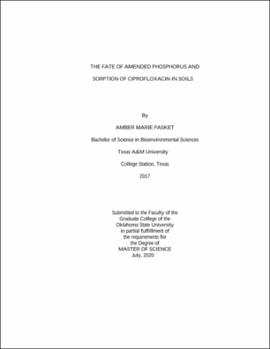| dc.contributor.advisor | Deng, Shiping | |
| dc.contributor.author | Pasket, Amber Marie | |
| dc.date.accessioned | 2021-02-22T22:41:21Z | |
| dc.date.available | 2021-02-22T22:41:21Z | |
| dc.date.issued | 2020-07 | |
| dc.identifier.uri | https://hdl.handle.net/11244/328666 | |
| dc.description.abstract | Environmental contamination from natural and anthropological sources is receiving increased attention due to risks to human and ecological health. Manure from concentrated animal feeding operations is generally applied to fields as a cost-efficient way of disposal. Antibiotics are used in animal feeding operations to prevent disease and promote growth. The heavy and continuous application of manure can negatively impact the environment due to the release of excess nutrients such as phosphorus and antibiotics which contribute to increasing rates of eutrophication and the emergence of resistant microorganisms. Soil samples from a century-long continuous winter wheat (Triticum aestivum L.) experiment was used to determine the fate of added phosphorus from manure and chemical fertilizers in soil. Comparing data from the years of 1998, 1999, 2000, 2006, and 2018 found that 100% of added phosphorus was accounted in all treatments. The added chemical fertilizer phosphorus in 89 consecutive years was either removed in the harvested wheat grain or remained in the top 0-30 cm of the soil, while about 40% of the added manure-phosphorus was found in the subsurface 30-90 cm of the soil profile. Following 119 years of manure application, manure-phosphorus did not reach deeper than 90 cm of soil, suggesting that leaching to groundwater is not a concern at this study site. Based on evaluation on sorption of ciprofloxacin in 20 diverse soils, sorption capacity ranged from 8 to 141 g kg-1; distribution coefficient (Kd) ranged from 23 to 200 mL kg-1 soil; and organic carbon-water partition coefficient (Koc) ranged from 54 to 2146 mL g-1 organic carbon. Clay content and cation exchange capacity influenced sorption capacity and Kd values significantly, while little influence was observed from soil pH. Cultivation led to changes in the quality of soil organic matter, resulted in a significant relationship between sorption of ciprofloxacin and soil organic carbon content. Soils are effective in restraining the mobility of ciprofloxacin through adsorption and the effectiveness increases with clay content. | |
| dc.format | application/pdf | |
| dc.language | en_US | |
| dc.rights | Copyright is held by the author who has granted the Oklahoma State University Library the non-exclusive right to share this material in its institutional repository. Contact Digital Library Services at lib-dls@okstate.edu or 405-744-9161 for the permission policy on the use, reproduction or distribution of this material. | |
| dc.title | Fate of amended phosphorus and sorption of ciprofloxacin in soils | |
| dc.contributor.committeeMember | Zhang, Hailin | |
| dc.contributor.committeeMember | Krzmarzick, Mark | |
| osu.filename | Pasket_okstate_0664M_16815.pdf | |
| osu.accesstype | Open Access | |
| dc.type.genre | Thesis | |
| dc.type.material | Text | |
| thesis.degree.discipline | Plant and Soil Sciences | |
| thesis.degree.grantor | Oklahoma State University | |
